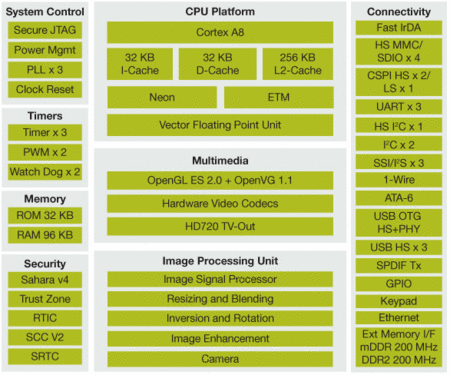Superscalar ARM SoC runs Linux
Jan 5, 2009 — by Eric Brown — from the LinuxDevices Archive — 5 viewsFreescale has launched a new Linux-ready system-on-chip (SoC) family based on ARM's Cortex-A8 core clocked from 800MHz to 1GHz. The HD-capable i.MX51 integrates OpenGL ES 2.0 and OpenVG 1.1 accelerators, and will be be delivered in several variants suitable for specific consumer electronics and embedded applications, Freescale says.
The first of the i.MX51 processors, announced today, is the netbook-focused i.MX515. Additional i.MX51 variants will be announced in the coming months, aimed at automotive devices and other embedded applications, said a Freescale spokesperson. The i.MX51 will also ship in a future extended temperature range version, he said.
The i.MX51 is based on ARM's Cortex-A8 superscalar core, which enables instruction-level parallelism within a single processor. The other established Cortex-A8 platform is the OMAP3x processor family from Texas Instruments (TI). In particular its OMAP35xx platform offers a similarly broad approach to the market, spanning both consumer electronics and general embedded devices, and similarly supporting HD video and Open GL ES 2.0.
Freescale's Cortex-A8 is equipped with 32KB L1 instruction, 32KB L1 data, and 256KB L2. The i.MX51 supports Mobile DDR and DDR2 SDRAM memories, as well as SLC/MLC NAND flash.
The SoC offers power management features including multiple independent power domains, power gating, and dynamic process and temperature compensation, says the company. A key power management feature is Freescale's DVFS (Dynamic Voltage and Frequency Scaling) technology, which is said to enable the 1GHz processor to throttle down a much lower voltage and frequency (as low as 200MHz), for tasks such as audio decode, thereby reducing power usage.

i.MX51 block diagram
(Click to enlarge)
Multimedia processing is enhanced by a multi-level cache system and multi-standard hardware-accelerated video and audio codecs, says Freescale. The SoC is also equipped with an autonomous Image Processing Unit (IPU) that offers image signal processing, image manipulation and enhancement, and CMOS camera sensor support. The i.MX51 integrates ARM's “NEON” SIMD media accelerator, which is said to offer 32-bit single-precision floating point support. In addition, the SoC comes with a variety of hardware video and audio codecs, as well as OpenGL ES 2.0 and OpenVG 1.1 accelerators for 3D graphics. The latter is said to enable Flash and SVG multimedia.
The SoC offers an LCD controller that supports both 24-bit primary (WXGA) and 18-bit secondary display ports. Peripheral support on the i.MX51 includes USB, Ethernet, and various serial interfaces. There are also MMC/SDIO expansion card interfaces, as well as ATA storage interfaces. In addition, the i.MX51 provides a variety of security features, including ARM TrustZone support, says the company.
Touted video and multimedia capabilities for the i.MX51 include:
- Video resolutions of up to HD 720p (1280×720)
- Hardware video de-interlacing
- Image and video resize, inversion, and rotation hardware
- Alpha blending and color space conversion
- Video/graphics combining (four planes plus hardware cursor)
- Color correction, gamut mapping, and gamma correction
Specifications listed for the i.MX51 include:
- Processor core — ARM Cortex A8 core running at 1GHz (@ 1.1 V), 800MHz (1.0 V), with dynamic downshift to as low as 200MHz (0.7 V)
- Cache — 32KB L1 instruction; 32KB L1 data; 256KB L2
- External memory interface — Mobile DDR and DDR2 SDRAM; 16/32-bit, 200MHz
- Flash interface — SLC/MLC NAND flash, 8/16-bit
- Co-processors — NEON SIMD media accelerator; vector floating point coprocessor
- Video/graphics accelerators:
- Image Processing Unit
- Hardware video codecs
- OpenGL ES 2.0 and OpenVG 1.1 accelerators
- Display interface — LCD controller, supporting 24-bit primary (WXGA) and 18-bit secondary display ports
- Video — HD 720p component TV output
- Security features:
- Security controller, including secure RAM and security monitor
- Secure high assurance boot
- JTAG controller
- Real-time clock
- Cipher and random number generator accelerators
- Run-time integrity checker
- Universal unique identification
- Tamper detection
- Camera interface — CMOS camera sensor interface
- Networking — Fast Ethernet controller
- USB interface — High-Speed USB On-The-Go; 3 x High-Speed USB hosts
- Expansion card interface — 4 x High-Speed MMC/SDIO Host
- Storage interfaces — CE-ATA, P-ATA
- Other interfaces:
- UARTs
- I2C
- I2S and S/PDIF audio
- SPI
- Packaging - 13 x 13mm (0.5mm pitch, MAPBGA package) or 19 x 19mm (0.8mm pitch, MAPBGA)
Availability
Freescale did not offer a specific timetable for upcoming i.MX51 SoCs. However, the netbook oriented i.MX515 is said to be sampling now to select customers. The company is also offering a reference design for the i.MX515, built by Pegatron, that features Ubuntu Linux. More information on the i.MX51 may be found here.
This article was originally published on LinuxDevices.com and has been donated to the open source community by QuinStreet Inc. Please visit LinuxToday.com for up-to-date news and articles about Linux and open source.